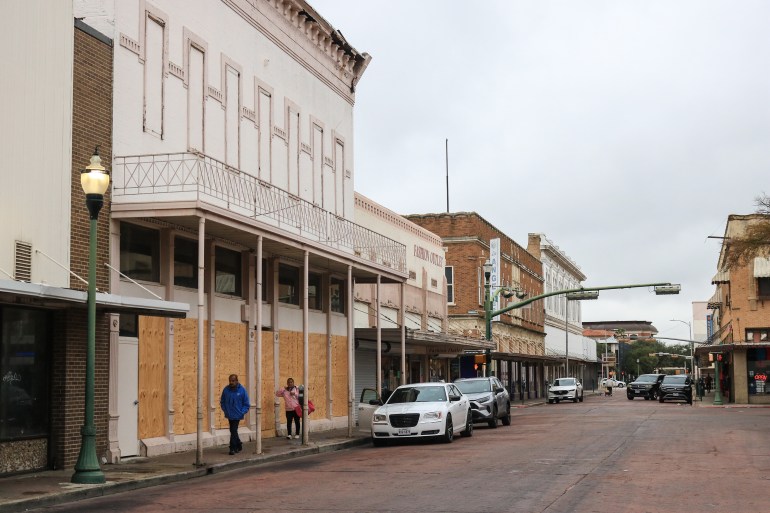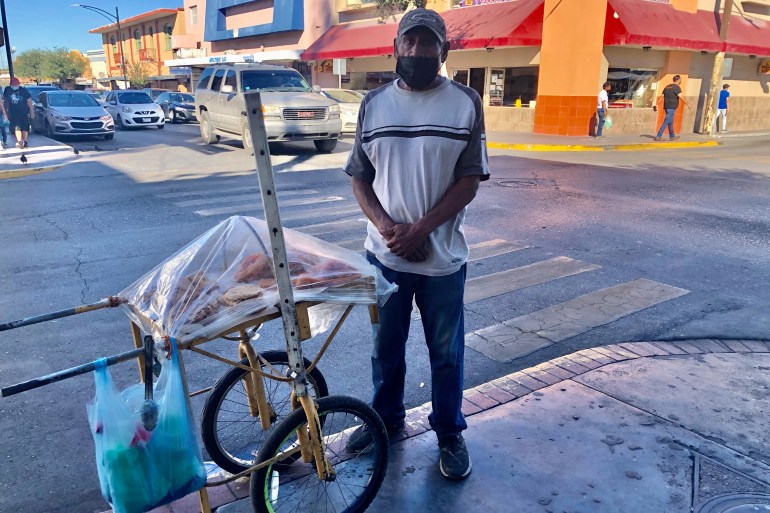Historic division of ‘the two Laredos’ ends with border reopening
Laredo, in the US and Nuevo Laredo, in Mexico are like one city, but pandemic closures created losses that might be hard to reclaim.

Laredo, Texas – For almost 20 months, Lilia Prado had not seen her elderly mother who lived a few miles away across the US-Mexico border, which had been closed by US authorities to non-essential travel in March 2020 at the onset of the COVID-19 pandemic.
Prado, a non-resident worker who cleans homes in Laredo, Texas, would not be allowed to return if she crossed into Mexico to visit her family across the river. Even when her brother died of COVID-19 in Nuevo Laredo last year, she could not attend the funeral with her mum.
Keep reading
list of 4 itemsThe inhumane futility of border policing
US-Mexico border crossing arrests reach record highs: Reports
‘I’m just hanging on’: Excitement for Canada-US border reopening
“They were the toughest times in my life,” Prado said on Monday, in the central plaza of downtown Laredo. “Not to be able to see my mom in the moment she needed me most.”

When the border reopened on Monday, Prado’s mother, 73-year-old Beatriz Mercado, left her home in Nuevo Laredo, Mexico, and crossed a pedestrian bridge into Texas to meet her daughter. In the central square of downtown Laredo, they hugged for the first time in a year and a half. Throughout the square, dozens of people who had just crossed the nearby border bridge waited for family members they had not seen in more than a year and a half.
Much was anticipated of the reopening Monday, with Customs and Border Protection agents warning of anticipated six-hour wait times to cross and Laredo’s strangled economy awaiting the return of crowds of Mexican shoppers who once made this place thrive. But when morning came, only a trickle of people were crossing the bridge, a sign that life in this bi-national community along both banks of the Rio Grande will not immediately snap back to how it used to be.
“I was surprised there was no line – nothing,” said Mercado as she hugged her daughter in the plaza.
The reopening marked the end of an historic disruption for this metro area known as “the two Laredos,” where about 450,000 people live on the Mexican side and 250,000 live in Texas.
While the border remained open to US citizens during that time, it was closed to almost all Mexican citizens across the river, and to the thousands of Mexican citizens who lived on the Texas side without residency permits. Certain essential workers – mostly related to Laredo’s massive and thriving inland port – were permitted to cross. The barrier separated families, cut thousands of people off from their livelihoods and forced the two sister cities, which predate the border, to grow apart across 18 months.
“Laredo and Nuevo Laredo are like one city with a river running through it,” said Sister Rosemary Welsh, executive director of Mercy Ministries of Laredo, who has done humanitarian work here since 1993. “This all used to be Mexico until we stole it.”
The two sister cities were one until the US took the territory in 1848, turning the Rio Grande into an international border. After that, the border was barely enforced until about the 1980s, said 75-year-old Ernesto Canche, who has worked in downtown Laredo since he was 15 years old.
For Canche, the border closure was the worst disaster he had seen in this city.
He lived through the devaluation of the Mexican peso in 1994 and the onset of border security after September 11, 2001. He weathered the outburst of war in northern Mexico that has cast a grim mood since 2006 across this once vibrant region.
“None of it affected us like this,” he said during his shift in a downtown clothing store. “This was terrible.”
A few city blocks from the Rio Grande, which divides the city, downtown Laredo has long been the central commercial district of the sister cities. People came here every day from Nuevo Laredo and all over parts of northern Mexico to shop. The area was more oriented towards customers from the Mexican side than to those in the US.
“The people with money don’t come here, they go to the big stores and the malls in the north,” said Jose Alvarado, manager of a t-shirt printing shop called Jerico, across from Laredo’s old city hall.

The area had been in decline for a decade, he said. Then, the pandemic border closure left half the stores boarded up or closed, with abandoned buildings on almost every city block. Even expensive malls in North Laredo lost a key customer base – vacationing shoppers from across Mexico who came by the hundreds each day to buy American clothing brands and electronic goods. Susie Torres, marketing director for CBL Properties, which owns Mall del Norte in north Laredo, said shoppers from Mexico accounted for up to 40 percent of sales there.
The border closure saw northbound crossings on the area’s main pedestrian bridge fall by about 60 percent, from about 1,834,000 in the first half of 2019 to about 1,482,000 in the first half of this year, according to data from the Texas Center at Texas A&M International University.
Non-commercial northbound vehicle crossings fell about 43 percent from about 2,133,000 to 1,209,000 during the same timeframe.

Thousands of people had commuted daily or weekly from the less affluent south to work in the US. The economies on both sides of the river have depended on the daily flow of workers between the two Laredos, said Israel Reyna, a lawyer with Texas RioGrande Legal Aid, which represents low-income clients at no cost.
In Nuevo Laredo, many people who used to work in the north have struggled to transplant their businesses.
“It’s been a really difficult time,” said 70-year-old Joel Arroyo, who pushed a small cart selling homemade sweets around the central zone of the Mexican city. “Not just for me, everyone was affected.”

He used to commute to Laredo each day to sell sweets in the summer and popsicles in the winter on the bustling streets of downtown. Back then, he took home at least $12 a day. Since the closure, he has tried to sell on the Mexican side but he seldom nets more than $5 a day.
Others like him, he said, have started taco businesses from their home kitchens or sold personal possessions to make ends meet.
On Monday, public officials gathered for a news conference at the main pedestrian bridge of the sister cities to celebrate the reopening. US Representative Henry Cuellar, a congressman from the Laredo region, said the US had lost out on about $30bn from Mexican consumers who used to spend in the US.
Carmen Lilia Canturosas, the mayor of Nuevo Laredo, acknowledged that the last 18 months had been a trying time for the community.
She told a crowd of reporters and city leaders gathered near the bridge, “I know that better times are coming for the two Laredos.”